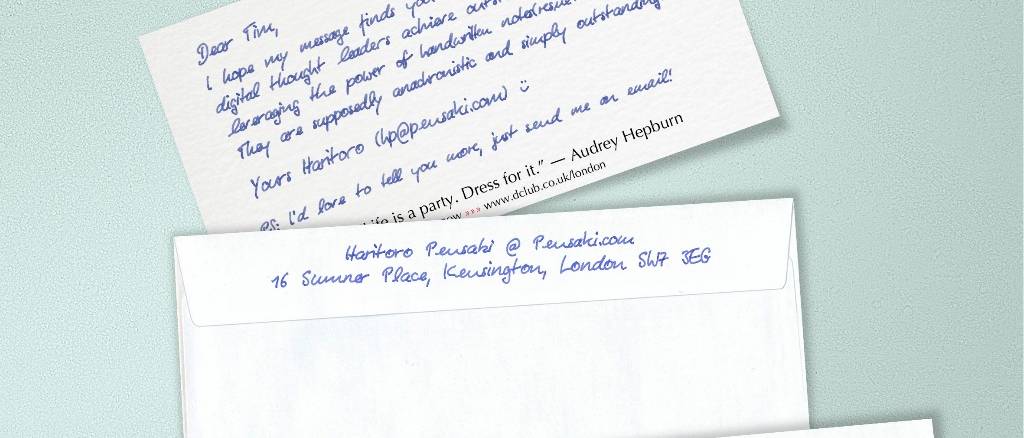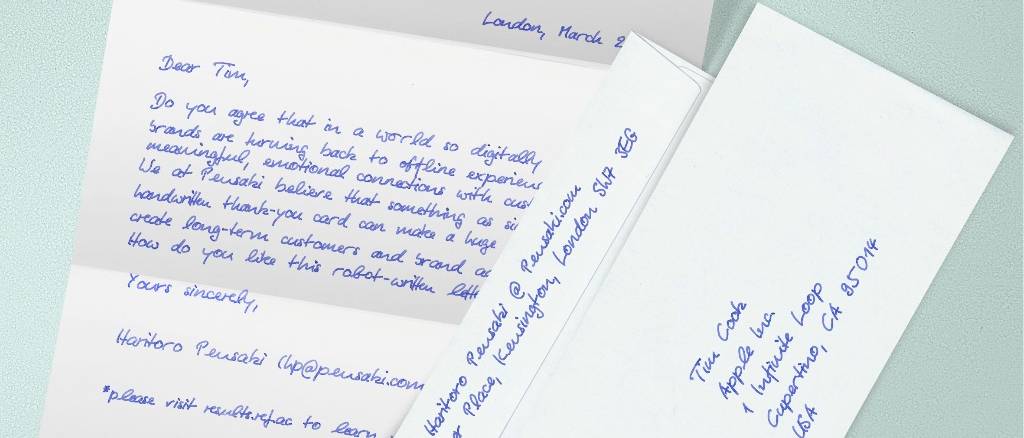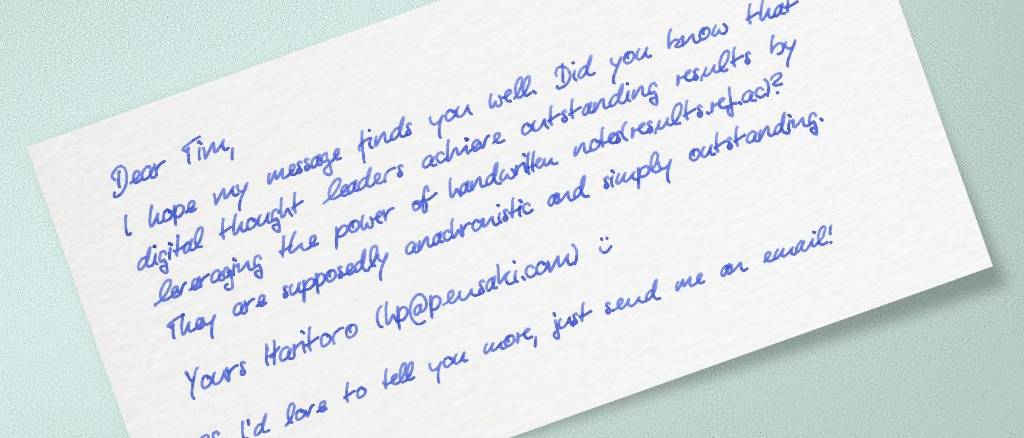Why Handwritten Letters Really Work In The Digital Age
Andrea
When we talk about handwritten letters and messages in today’s digital age, it sounds more like a step backward than progress. Even though digitization has yielded many advantages for us over the last few decades, it also has considerable disadvantages.
We are overwhelmed by an overload of messages. To get this sorted as quickly as possible, we have to react with automatisms. For example, e-mails that look like advertising are immediately declared as such by our brain, and they end up in the trash without being read. How do you manage to reach potential customers nowadays? Are handwritten letters a possible alternative?
How to stand out from the digital flood
Marketing experts have already recognized that conventional snail-mail is now a good way of reaching people again. But many others also resort to this type of communication, albeit often very uninspired and uncreative. Handwritten letters will definitely get you noticed. Today it’s more and more about how to use handwriting to communicate unique messages most effectively.
How does the ideal handwritten message look like?
You don’t have to write a long novel. Get to the point instead. A few personal lines on the back of a postcard can produce tremendous results. Marc Zuckerberg, for example, writes two to three handwritten cards to customers, colleagues, and service providers every day. You can be absolutely sure that the recipients of these cards will have their full attention. When was the last time you received a handwritten message from your boss, a colleague, or a supplier? Even if the message on the postcard is concise, it works. It already stands out in a pile of machine-generated mailings and invoices you receive daily. You might even pin it on the wall within sight after reading. Therefore, it has a lasting effect; you will remember it for a long time. Such achievements open up a whole new perspective for corporate communication. Handwritten messages surprises are kept in mind by the recipients.
Creating Memorable Experiences By Focusing On The Perceived Value
While marketing departments focus on reaching many people without spending much money, it’s no longer as easy as it was. The cheapest option is to start an e-mail campaign. But it is crucial to get past spam filters and get the recipient of the message to read the message. Studies have shown that 92% of managers don’t even read advertising e-mails. Most of the time, your message won’t get anywhere. So far, the click rates have been happily analyzed, whereby one important factor has always been left out: communication is not to be equated with information. Understanding always takes place on several levels, such as on the emotional. Only if you reach the customer exactly there can you build a relationship with them.
A handwritten message conveys an exceptional appreciation from the recipient. Someone went out of their way and invested the time to get in touch with you. Apart from that, the creativity of the message and the perceived costs incurred by the sender are also registered. Rory Sutherland, a British marketing expert, calls it “costly signaling.”
Handwritten letters: no appreciation without the sense of value
Electricity providers have taken advantage of this surprise effect by sending personal handwritten postcards without much advertising content. This campaign aimed to get feedback from the recipient. In a first mailing, the provider sent their former electricity customers 10,000 postcards with a personal offer, including a one-time credit as a thank you.
In the second wave of mailings two weeks later, flyers were added in a handwritten envelope. Only because of this handwritten address, nearly all envelopes were opened! This campaign resulted in 9-12% returnees to the former provider. With 10,000 households contacted, we’re talking about 1,200 new customers – what a result!
How you can win new customers with handwritten mailings
Electricity providers have taken advantage of this surprise effect by sending personal handwritten postcards without much advertising content. This campaign aimed to get feedback from the recipient. In a first mailing, the provider sent their former electricity customers 10,000 postcards with a personal offer, including a one-time credit as a thank you.
In the second wave of mailings two weeks later, flyers were added in a handwritten envelope. Only because of this handwritten address, nearly all envelopes were opened! This campaign resulted in 9-12% returnees to the former provider. With 10,000 households contacted, we’re talking about 1,200 new customers – what a number!
Of course, you can send a brief text message or post on the Facebook timeline to wish Happy Birthday or Merry Christmas. However, this doesn’t express a high level of appreciation. This type of communication is too generic and may get lost with all the other messages.
This materiality plays a significant role in terms of value, which also explains the continued popularity of analog media such as books, records, or photos on actual paper. However, all of this has long been available in digital form. Consumer research found out that people are willing to pay more for physical goods because they attribute more significant value. This, in turn, also has to do with the fact that objects you can hold in hand trigger significantly more positive emotions.
Therefore, handwritten letters and postcards have a double effect on the recipient. On the one hand, through the expression of personal style, signaled by the handwriting, on the other hand through the possibility of being able to feel the message. Together they beckon a special appreciation: Someone has taken the time and effort to put text on paper and send it by post instead of typing it in the phone or computer and just sending it off with a slight tap of the finger.
If you can deliver this feeling of appreciation with your handwritten messages, you will see measurable results, such as higher response rates. This has to do with the basic rules of social behavior. If someone is doing us a favor, we feel obliged to reciprocate that gesture. According to the marketing expert and social psychologist Robert B. Cialdini, taking into account the so-called “principle of reciprocity” is one of the most critical success factors in marketing.
Mailing 10,000 handwritten postcards ?
You may say okay, but how are you supposed to produce a large number of handwritten letters or postcards for a mailing? You neither have the time nor the money to withdraw employees for this task or hire new ones. You can use external agencies, but they are usually quite expensive.
This is where the friendly handwriting robots from Pensaki come into play. You can create high-quality messages of various lengths and any content that looks absolutely authentic. And it all is without errors and always in even writing because the robots don’t even know what fatigue is.
You will receive results in natural-looking handwriting, written with a stylograph or ballpoint pen on high-quality paper. But not only the message itself is important, but also everything with it, like the handwritten address and addressor on the envelope, and an actual postage stamp. This letter will stand out in every mailbox or stick out from any pile on the desk. Surveys have shown that 80% of Germans are happy about a handwritten message. The opening rate of handwritten letters is up to 90%! Besides, advertising letters written by hand achieve a response rate between 10 and 40% when acquiring new customers. Provided you consider the success factors.
To convince yourself of the high quality and authenticity of our robots’ handwritten postcards and letters, simply request a free sample from our showroom. You can choose from many different stationery and cards in our shop and specify the robot handwriting. Just upload your message, and we’ll take care of the rest. Check outwhat our customers say about our handwritten letters and postcards. We ship worldwide via UPS!
Be smart and sign up for our newsletter!
Your competition keeps itself up to date.


